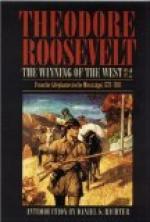Through the long, irksome winter, the frontiersmen remained crowded within the stockades. The men hunted, while the women made the clothes, of tanned deer-hides, buffalo-wool cloth, and nettle-bark linen. In stormy weather, when none could stir abroad, they turned or coopered the wooden vessels; for tin cups were as rare as iron forks, and the “noggin” was either hollowed out of the knot of a tree, or else made with small staves and hoops. [Footnote: McAfee MSS.] Every thing was of home manufacture—for there was not a store in Kentucky,—and the most expensive domestic products seem to have been the hats, made of native fur, mink, coon, fox, wolf, and beaver. If exceptionally fine, and of valuable fur, they cost five hundred dollars in paper money, which had not at that time depreciated a quarter as much in outlying Kentucky as at the seat of government. [Footnote: Marshall, p. 124.]
As soon as the great snow-drifts began to melt, and thereby to produce freshets of unexampled height, the gaunt settlers struggled out to their clearings, glad to leave the forts. They planted corn, and eagerly watched the growth of the crop; and those who hungered after oatmeal or wheaten bread planted other grains as well, and apple-seeds and peach-stones. [Footnote: McAfee MSS.]
Many New Settlers Arrive in the Spring.
As soon as the spring of 1780 opened, the immigrants began to arrive more numerously than ever. Some came over the Wilderness road; among these there were not a few haggard, half-famished beings, who, having stalled too late the previous fall, had been overtaken by the deep snows, and forced to pass the winter in the iron-bound and desolate valleys of the Alleghanies, subsisting on the carcasses of their stricken cattle, and seeing their weaker friends starve or freeze before their eyes. Very many came down the Ohio, in flat-boats. A good-sized specimen of these huge unwieldly scows was fifty-five feet long, twelve broad, and six deep, drawing three feet of water; [Footnote: Lettres d’un Cultivateur Americain, St. John de Creve Coeur, Paris, 1787. p. 407. He visited Kentucky in 1784.] but the demand was greater than the supply, and a couple of dozen people, with half as many horses, and all their effects, might be forced to embark on




